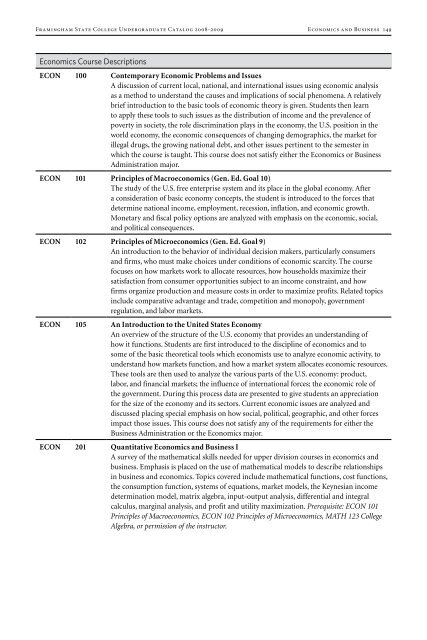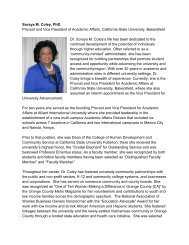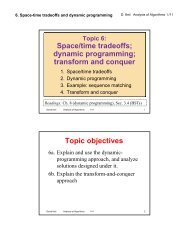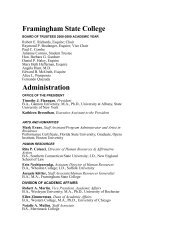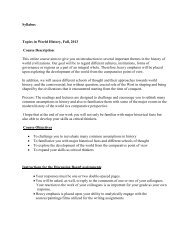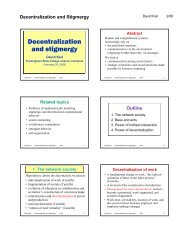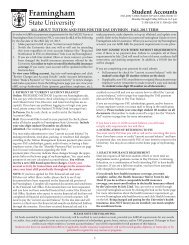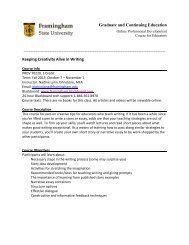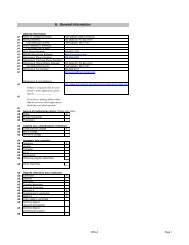Economics and Business Administration - Framingham State ...
Economics and Business Administration - Framingham State ...
Economics and Business Administration - Framingham State ...
Create successful ePaper yourself
Turn your PDF publications into a flip-book with our unique Google optimized e-Paper software.
<strong>Framingham</strong> <strong>State</strong> College Undergraduate Catalog 2008-2009 <strong>Economics</strong> <strong>and</strong> <strong>Business</strong> 149<br />
<strong>Economics</strong> Course Descriptions<br />
eCon 100 Contemporary economic Problems <strong>and</strong> Issues<br />
A discussion of current local, national, <strong>and</strong> international issues using economic analysis<br />
as a method to underst<strong>and</strong> the causes <strong>and</strong> implications of social phenomena. A relatively<br />
brief introduction to the basic tools of economic theory is given. Students then learn<br />
to apply these tools to such issues as the distribution of income <strong>and</strong> the prevalence of<br />
poverty in society, the role discrimination plays in the economy, the U.S. position in the<br />
world economy, the economic consequences of changing demographics, the market for<br />
illegal drugs, the growing national debt, <strong>and</strong> other issues pertinent to the semester in<br />
which the course is taught. This course does not satisfy either the <strong>Economics</strong> or <strong>Business</strong><br />
<strong>Administration</strong> major.<br />
eCon 101 Principles of Macroeconomics (gen. ed. goal 10)<br />
The study of the U.S. free enterprise system <strong>and</strong> its place in the global economy. After<br />
a consideration of basic economy concepts, the student is introduced to the forces that<br />
determine national income, employment, recession, inflation, <strong>and</strong> economic growth.<br />
Monetary <strong>and</strong> fiscal policy options are analyzed with emphasis on the economic, social,<br />
<strong>and</strong> political consequences.<br />
eCon 102 Principles of Microeconomics (gen. ed. goal 9)<br />
An introduction to the behavior of individual decision makers, particularly consumers<br />
<strong>and</strong> firms, who must make choices under conditions of economic scarcity. The course<br />
focuses on how markets work to allocate resources, how households maximize their<br />
satisfaction from consumer opportunities subject to an income constraint, <strong>and</strong> how<br />
firms organize production <strong>and</strong> measure costs in order to maximize profits. Related topics<br />
include comparative advantage <strong>and</strong> trade, competition <strong>and</strong> monopoly, government<br />
regulation, <strong>and</strong> labor markets.<br />
eCon 105 an Introduction to the united <strong>State</strong>s economy<br />
An overview of the structure of the U.S. economy that provides an underst<strong>and</strong>ing of<br />
how it functions. Students are first introduced to the discipline of economics <strong>and</strong> to<br />
some of the basic theoretical tools which economists use to analyze economic activity, to<br />
underst<strong>and</strong> how markets function, <strong>and</strong> how a market system allocates economic resources.<br />
These tools are then used to analyze the various parts of the U.S. economy: product,<br />
labor, <strong>and</strong> financial markets; the influence of international forces; the economic role of<br />
the government. During this process data are presented to give students an appreciation<br />
for the size of the economy <strong>and</strong> its sectors. Current economic issues are analyzed <strong>and</strong><br />
discussed placing special emphasis on how social, political, geographic, <strong>and</strong> other forces<br />
impact those issues. This course does not satisfy any of the requirements for either the<br />
<strong>Business</strong> <strong>Administration</strong> or the <strong>Economics</strong> major.<br />
eCon 201 Quantitative economics <strong>and</strong> <strong>Business</strong> I<br />
A survey of the mathematical skills needed for upper division courses in economics <strong>and</strong><br />
business. Emphasis is placed on the use of mathematical models to describe relationships<br />
in business <strong>and</strong> economics. Topics covered include mathematical functions, cost functions,<br />
the consumption function, systems of equations, market models, the Keynesian income<br />
determination model, matrix algebra, input-output analysis, differential <strong>and</strong> integral<br />
calculus, marginal analysis, <strong>and</strong> profit <strong>and</strong> utility maximization. Prerequisite: ECON 101<br />
Principles of Macroeconomics, ECON 102 Principles of Microeconomics, MATH 123 College<br />
Algebra, or permission of the instructor.


